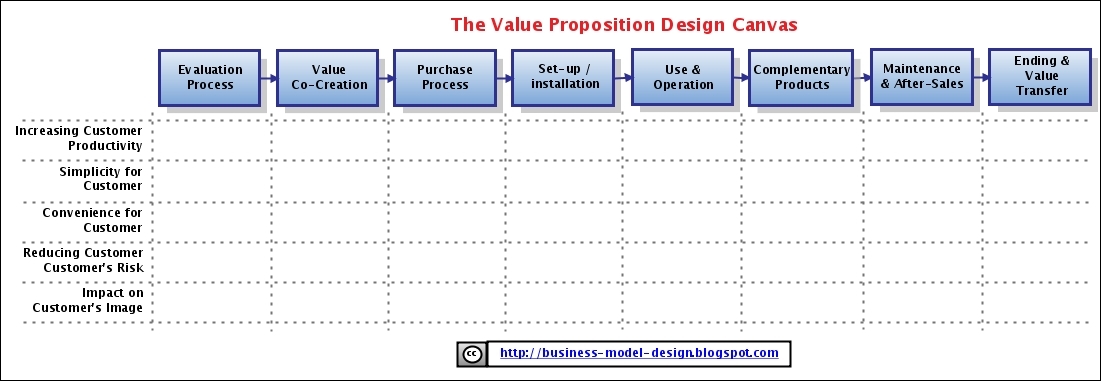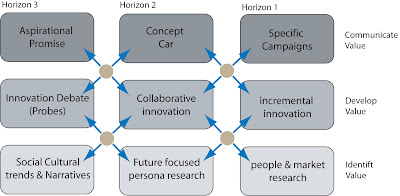
Alex Osterwalder, the author of Business Model Design and Innovation Blog shares this amazing framework to communicate the various phases of the value proposition life cycle. Design has always been able to create values through intuition, based on the desire to improve the quality of things, that feel wrong or can be better. Now we need to clearly deliver the message that the possibilities we explore can make a tremendous difference in all of these areas. Then let's talk about strategy...
8 Phases of Value Proposition:
- Evaluation Process: A company can create customer value by making the evaluation process as easy as possible. In the phase of the life cycle a customer will try to understand if a company's value proposition satisfies its needs.
Example: Software companies often allow their customers to freely and easily test their products.
Example: Ski gear companies organize special camps to allow their best customers to test all their newest material. - Value Co-Creation: Through various technological advances the integration and participation of the customer in the value creation process is increasingly possible.
Read more: Frank Piller of TU Munich and MIT writes a lot of interesting material on mass-customization.
Watch more: Eric Van Hippel of MIT outlines in a video how customers can be integrated to design new and innovative products that correspond to their needs. You can also download his book on democratizing innovation. - Purchase Process: Customers highly value an efficient, simple and convenient purchase process.
Example: Amazon's "one click shopping" makes buying on its website a very quick and efficient process. - Set-up/Installation: In some cases set-up or installation is necessary. The simplification of this process is of enormous value to the customer.
- Use & Operation: In many cases most of the value in a value proposition comes from the use or operation of an actual product or service. However, to differentiate themselves companies try to create value beyond a simple product or service.
Example: For customers the main value from Salesforce.com's value proposition comes from the use of its hosted sales force solution. Yet, Salesforce is carefully creating additional value by offering continuous updating "behind the scences" and providing easy access to complementary products by third party vendors. - Complementary Products/Services: Value is also created if a value proposition boosts the value of complementary products and services or is itself a platform for valuable complementary products/services.
- Maintenance & After-Sales: Value is often created during the maintenance and after-sales phase. This can be either by offering high quality service or by offering a value proposition that minimizes the need for maintenance & after-sales.
Example: The attractiveness of Salesforce.com's value proposition essentially comes from the fact that the hosted software model (application service provider - ASP) minimizes the need of software maintenance by the customer. - Ending & Value Transfer: In many cases once a customer does not need a product or service anymore he has to terminate the service or dispose of the product.
Example: ending the subscription of a magazine
Example: disposing of batteries
- Productivity & Returns: value is created by increasing a customer's productivity, his returns and his utility.
- Simplicity: value is created by making each phase of the value proposition life cycle as simple as possible to understand. For example, a software company can make the parametrization of its software as simple as possible.
- Convenience: value is created by making a customer's life as convenient as possible. For example, an online grocer creates value by delivering goods at the time the customer desires.
- Risk: value is created by minimizing a customer's various risks. For example, a customer risks choosing a product/service that does not satisfy his needs, or he may incur a physical risk by using the product (e.g. lawn mower) or he may risk choosing a product at the wrong moment (e.g. buying a plasma TV just before an important price decrease).
- Image: value is created by the image a product/service gives its purchaser (e.g. iPod)












